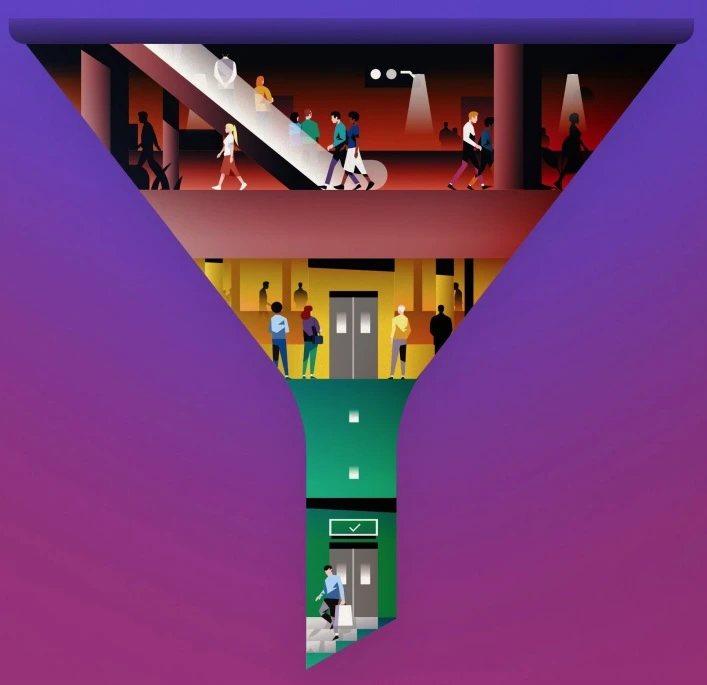
Introduction: Steps in a Sales Process
Sales process is a series of ordered and value-added steps towards a predetermined goal which is a sale. Almost every business has their own sales process which dictates how their sales operations are managed. Usually business´s sales process is well planned and used in day-to-day sales activities. In this article lets see the 7 Important steps in a sales process
Acquiring customers involves using a variety of marketing, sales and support steps with the goal of converting prospective customers into paying ones. The sales process is often illustrated as a funnel which consists of several steps in a sales process. Prospective customers are inputted at the top and some percentage of the prospects is successfully converted to the next stage, making the funnel narrower as the process continues.
The Sales Funnel

What does Sales Funnel mean?
A sales funnel, or a marketing funnel, is a process that businesses can use to turn website visitors or prospects into paying customers. It’s a way of creating the right type of content (or experience) at each stage of the customer journey, and moving customers to a point of purchase.
There are several approaches to sales funnel and as a result for different approaches, there exists different names for different funnel stages.
Must Read: SALES PITCHING SCRIPT (THE ULTIMATE GUIDE)
7 Steps in a Sales Process
Traditional model consists of seven steps in a Sales process:
- Prospecting and Qualifying
- Pre-Approach
- Approach
- Presentation and Demonstration
- Handling Objections
- Closing
- Follow-Up.
Decoding the 7 Steps in a Sales Process

Prospecting and Qualifying:
- The first step in the Steps in a Sales Process is prospecting which means identifying qualified potential customers. Approaching the right potential customers is crucial to the selling process and also increasing prospecting effectiveness is the fastest way to boost sales.
- Prospects can be qualified by their financial ability, volume of business, special needs, location, and also possibilities for growth. For salespeople the best sources of leads are referrals such as current customers, suppliers, dealers, noncompeting salespeople, and Web or other social networks. Prospects can also be searched in newspapers, trade journals, phone or web directories and tracked down by telephone and also email.
Pre-approach
- Pre-approach is the second step in the selling process. Before contacting a prospect, the salesperson must learn as much as possible about the organization and also its buyers.
- Gathering information allows the salesperson to understand possible problems even before discussing them with the prospect. salesperson can consult standard industry and online sources, talk to acquaintances and also others that might have valuable information about the company.
- At this point the salesperson must also determine the best approach method (personal visit, phone call, email) and also the best timing of the approach.
Approach
- The objective of the approach step is to get the relationship off to a good start.
- During the approach it is in important to ask key questions about the customer´s needs or otherwise attract the buyer’s attention.
- As in all the stages, listening to the customer is crucial.
Presentation and Demonstration
- During the presentation, the salesperson explains the “value story” to the buyer and also shows how the company´s offering solves the customer´s problems. This is called a customer-solution approach.
- The buyer wants to know how the offering will add value to their business. Buyers want the salespeople to listen to their concerns, understand their needs, and respond with the right products and also services.
- The sales presentation must also be carefully planned. In today´s information-overloaded environment customers demand richer presentation experiences.
Handling Objections
- Most customers will always have objections during the presentation that are either logical or psychological and often unspoken.
- To handle these objections, the salesperson should try to find out hidden objections, ask the customer to clarify any objections and also taking these objections as opportunities to present more information. If properly handled, these objections can be turned into reasons for buying. This is one of the crucial Steps in a Sales Process.
Closing
At the end the salesperson tries to close the sale. For some salesperson this might prove difficult as they might lack the confidence, feel guilty about asking for the order, or fail to recognize the right moment to close the sale. Salespeople can use several techniques. This is one of the important Steps in a Sales Process.
- Asking for the order, reviewing points of agreement, and also offering to help in writing the order.
- The salesperson can also offer special reasons to close such as lower prices or extra quantities if the order is done right away.
Follow-Up.
- The final step in the process is follow-up which is necessary if the salesperson wants to ensure customer satisfaction and also continuity of the business relation. This is one of the important Steps in a Sales Process.
- A follow-up call or a meeting should be done after the buyer receives the initial order to make sure proper installation, instruction, and also serving occurred.
- This assures the buyer of the salesperson´s interest, and reduces buyer concerns that might have arisen after the sale.
SALES PROCESS FAQ
What are the 7 steps of the sales process?
The seven steps in a Sales process are
- Prospecting and Qualifying
- Pre-Approach
- Approach
- Presentation and Demonstration
- Handling Objections
- Closing
- Follow-Up.
What is sales process in sales?
Sales process is a series of ordered and value-added steps towards a predetermined goal which is a sale.
What are sales funnels?
A sales funnel, or a marketing funnel, is a process that businesses can use to turn website visitors or prospects into paying customers. It’s a way of creating the right type of content (or experience) at each stage of the customer journey, and moving customers to a point of purchase.
What are the 5 stages of sales funnels?
The 5 stages of sales funnels are
- Awareness
- Interest.
- Desire
- Action
- Loyalty
LIKE WHAT YOU’RE READING?
CHECK OUT SOME OF OUR OTHER GREAT CONTENT HERE:
- EFFECTIVE METHODS OF SALES PROMOTION TO WIN MORE CUSTOMERS
- ROLE OF BLOGS IN MARKETING
- MEANING OF MARKETING SEGMENTATION
- MARKETING MANAGER ROLES AND RESPONSIBILITIES
- UNDERSTANDING DIGITAL MARKETING
- WHAT IS AFFILIATE MARKETING? (HOW TO GET STARTED)
- PERFORMANCE MARKETING – A BEGINNER’S GUIDE
- EFFECTIVE BRANDING METHODS
- UNDERSTANDING CONSUMER BEHAVIOR
- HOW AI IS USED IN DIGITAL MARKETING?
- 5 BEST SOCIAL MEDIA PLATFORMS FOR BUSINESS IN 2022
- WHAT IS THE DEFINITION OF ECOMMERCE
- ROLE OF SOCIAL MEDIA IN MARKETING
- WHAT IS ZERO-BASED BUDGETING
- 5 BEST MARKETING STRATEGY IN PRODUCT LIFE CYCLE FOR 2023
- 8 STRATEGIES OF RETAIL MARKETING TO DRIVE SALES
- WHAT IS THE IMPORTANCE OF MARKETING IN A BUSINESS?




5 Comments